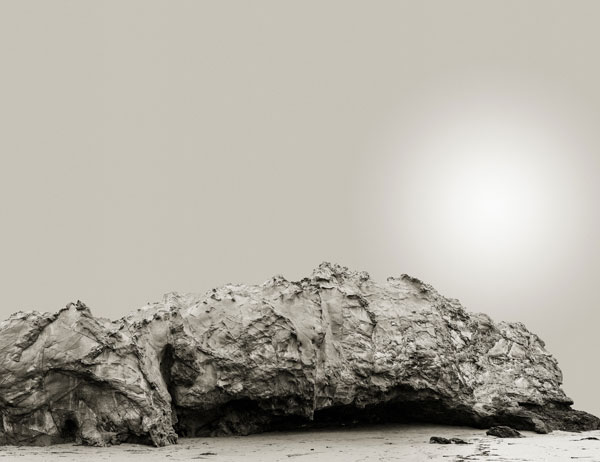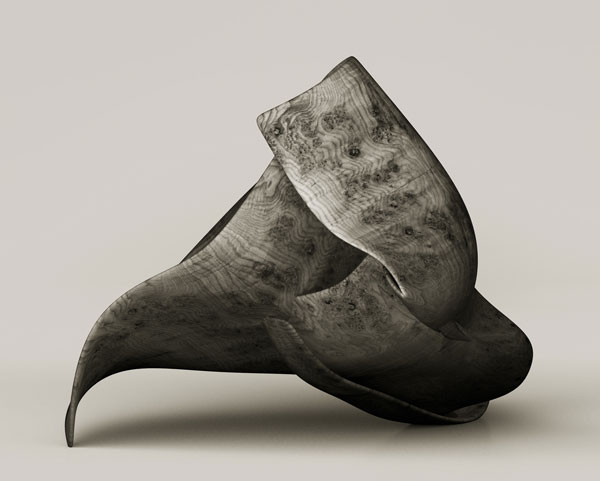Amir Zaki’s lushly photographed black-and-white landscapes introduce tension between formalist notions of timeless beauty and suspicions of digital photography’s reliability—or lack thereof. These photos of California’s coast, drawn from a series aptly named “Rocks,” comprise eight of the 12 images shown in “Formal Matter,” his exhibition of photographs from two distinct, but conceptually and formally interrelated bodies of work. The remaining four, from the series “Carvings,” convey the appearance of carved wooden forms, and extend Zaki’s interest in considering photography’s presumptive veracity.
“Rocks” invites comparisons with antecedents like Edward Weston, for example, who began photographing Point Lobos nearly 90 years ago. Weston was a master of framing the image, as is Zaki. Yet their methodologies—and their intentions, it would seem—are vastly different. Zaki photographs with a GigaPan device, enabling him to seamlessly stitch together multiple images, making his landscapes suspect in a way that working in analog media never was—despite the availability of darkroom tricks and retouching. Yet it is not entirely the digital that creates this crisis; it resides as much in the act of making the photograph.

Amir Zaki, Rock 12, 2016, ©Amir Zaki, courtesy of the artist and ACME Los Angeles.
Zaki composes to limit references of scale, imbuing the images with a sense of grandeur, and prompting the question: How much do we believe in the mythology of the monumental image? Some of the photographs, Rock #12 (all works 2016), for example, seem fantastic, as if the massiveness of the formations tests the limits of credibility. However, details reveal themselves on close inspection; birds perch on a craggy promontory in Rock #29, or a distant cliff provides perspective in Rock #69.
Zaki sustains this tension by exploiting the ambiguity between presenting an idealized vision of nature and deconstructing it. As with all photography, the abundance of detail and complexity of the image suggests the presence of the thing itself. The substantial scale of the prints offers an almost encompassing visual field, and as such, these photographs absorb the viewer.
The “Carvings” series, a body of manipulated digital images that appear to depict contorted planar forms, also stretch the boundaries of believability, but much more brazenly. The gnarled forms resemble elaborate carvings, or perhaps planks that have been steamed and sun-dried, contracting in on themselves.
These planar forms convey a beauty and formality that make each image beguiling, as does the sense that these works, more than their counterparts in the “Rocks” series, resemble graphite drawings (all of the photographs are printed on rag paper, and the surfaces, matte and supple, suggest the sensuousness of drawing). In Carving #8, an area of shadow has been darkened uniformly to eliminate nearly all detail of grain. The subtle play of surface and edge is full of deliberation and choice, and is both artificial and ambiguous, so that we’re never sure what we are seeing. Despite the illusion of drawing, photography is never far off. “Carvings” suggest a possible ironic take on an earlier era’s idealized forms, recalling Weston’s peppers or Imogen Cunningham’s flora, for example Magnolia Blossom (1925). The interplay of the two series activates Zaki’s theoretical concerns, but as objects, the photos are sublime.


